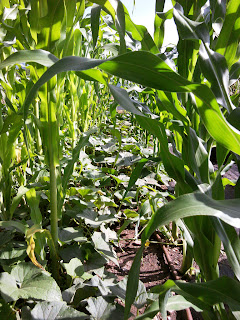 |
| Picture taken 7.2.11 |
Every year, I long to make pickles. I plant a few pickling cucumber plants and harvest a paltry few cukes, and usually end up running down to the farmers market to supplement my yield enough to can 3 or 4 quarts of pickles. So this year, I vowed to plant more cucumbers than I thought I needed in the hopes that I would end up with just enough.
I also tried another trick and I stuck all 5 plants in the same bed with 2 rows of corn. I thought the cornstalks might give the vines something to trellis on, and the cukes might in turn shade the corn's roots.
Well, it worked.
 |
| Picture of same bed taken 7.29.11 |
My favorite pickle is a crisp, sour, garlicky, dill pickle. Next best are the snappy, spicy pickles, and then there are the sweet slices of pickles that perfectly complement a deli sandwich on rye bread. All have their place at the table, and I plan to make a batch each of them before my vines quit for the year.
Here's the recipe I used to make my first batch of crisp garlic dills:
Brine: 1 cup distilled vinegar, 1 cup water, 1 Tbsp pickling salt, brought to a boil. Maintaining the proportions, make as much brine as you need. I think it's better to dump some extra down the drain than to run out mid jar.To each hot sterilized quart jar I added:
- 1 tsp dill seed
- 1 sprig fresh dill weed
- 2 cloves fresh garlic, coarsely chopped (don't worry if your garlic turns blue or green after canning...it's just the acid reacting with the oils)
- 1/2 tsp either mustard seed or whole pepper corns...we'll see which tastes best
- Pickling cukes (which I first soaked in ice water for 2-3 hours)
Then I processed them for 20 minutes in my waterbath canner. I think at sea level, you'd be fine to process them for 15 minutes, higher altitudes need longer in the canner.
One more quick note: A shrewd canning friend taught me to keep my waterbath canner boiling on my barbecue burner outside to help keep the kitchen cool for canning. Mine now gets set on the barbecue burner in late June and doesn't come in until all the produce has been put up at the end of September.
So now the pickle jars are supposed to sit for a few (6-8) weeks for best flavor, but my friend Cathy couldn't wait and already popped the seal on the first batch. She said they were delish! I'm gonna wait for mine.


The pickles with grape leaves were every bit as crisp, if not crisper than the ones I processed with commercial crisper. This year, all pickles will be processed with a grape leaf!
ReplyDelete